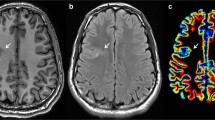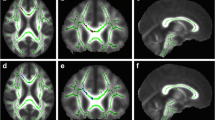Abstract
Purpose
Despite evidence for macrostructural alteration in epilepsy patients later in life, little is known about the underlying pathological or compensatory mechanisms at younger ages causing these alterations. The aim of this work was to investigate the impact of pediatric epilepsy on the central nervous system, including gray matter volume, cerebral blood flow, and water diffusion, compared with neurologically normal children.
Methods
Inter-ictal magnetic resonance imaging data was obtained from 30 children with epilepsy ages 1–16 (73% F, 27% M). An atlas-based approach was used to determine values for volume, cerebral blood flow, and apparent diffusion coefficient in the cerebral cortex, hippocampus, thalamus, caudate, putamen, globus pallidus, amygdala, and nucleus accumbens. These values were then compared with previously published values from 100 neurologically normal children using a MANCOVA analysis.
Results
Most brain volumes of children with epilepsy followed a pattern similar to typically developing children, except for significantly larger putamen and amygdala. Cerebral blood flow was also comparable between the groups, except for the putamen, which demonstrated decreased blood flow in children with epilepsy. Diffusion (apparent diffusion coefficient) showed a trend towards higher values in children with epilepsy, with significantly elevated diffusion within the thalamus in children with epilepsy compared with neurologically normal children.
Conclusion
Children with epilepsy show statistically significant differences in volume, diffusion, and cerebral blood flow within their thalamus, putamen, and amygdala, suggesting that epilepsy is associated with structural changes of the central nervous system influencing brain development and potentially leading to poorer neurocognitive outcomes.

Similar content being viewed by others
References
Guerrini R (2006) Epilepsy in children. Lancet 367:499–524
Hauser WA, Annegers JF, Kurland LT (1993) Incidence of epilepsy and unprovoked seizures in Rochester, Minnesota: 1935-1984. Epilepsia 34:453–468
MacEachern SJ, D'Alfonso S, McDonald RJ et al (2017) Most children with epilepsy experience postictal phenomena, often preventing a return to normal activities of childhood. Pediatr Neurol 72(42–50):e43
Danguecan AN, Smith ML (2017) Academic outcomes in individuals with childhood-onset epilepsy: mediating effects of working memory. J Int Neuropsychol Soc:23(7):594–604
Hamiwka LD, Wirrell EC (2009) Comorbidities in pediatric epilepsy: beyond “just” treating the seizures. J Child Neurol 24:734–742
Ottman R, Lipton RB, Ettinger AB, Cramer JA, Reed ML, Morrison A, Wan GJ (2011) Comorbidities of epilepsy: results from the epilepsy comorbidities and health (EPIC) survey. Epilepsia 52:308–315
Berg AT, Baca CB, Rychlik K et al (2016) Determinants of social outcomes in adults with childhood-onset epilepsy. Pediatrics 137
Gilmore JH, Lin W, Prastawa MW, Looney CB, Vetsa YS, Knickmeyer RC, Evans DD, Smith JK, Hamer RM, Lieberman JA, Gerig G (2007) Regional gray matter growth, sexual dimorphism, and cerebral asymmetry in the neonatal brain. J Neurosci 27:1255–1260
Knickmeyer RC, Gouttard S, Kang C et al (2008) A structural MRI study of human brain development from birth to 2 years. J Neurosci 28:12176–12182
Sampaio RC, Truwit CL (2001) Myelination in the developing human brain. Handbook of developmental cognitive neuroscience:35–44
Forkert ND, Li MD, Lober RM, Yeom KW (2016) Gray matter growth is accompanied by increasing blood flow and decreasing apparent diffusion coefficient during childhood. AJNR Am J Neuroradiol 37:1738–1744
Holmes GL, Ben-Ari Y (2001) The neurobiology and consequences of epilepsy in the developing brain. Pediatr Res 49:320–325
Lee JH, Kim SE, Park CH et al (2015) Gray and white matter volumes and cognitive dysfunction in drug-naive newly diagnosed pediatric epilepsy. Biomed Res Int 2015:923861
O'Muircheartaigh J, Vollmar C, Barker GJ, Kumari V, Symms MR, Thompson P, Duncan JS, Koepp MJ, Richardson MP (2011) Focal structural changes and cognitive dysfunction in juvenile myoclonic epilepsy. Neurology 76:34–40
Overvliet GM, Besseling RM, Jansen JF et al (2013) Early onset of cortical thinning in children with rolandic epilepsy. Neuroimage Clin 2:434–439
Baram TZ (2012) The brain, seizures and epilepsy throughout life: understanding a moving target. Epilepsy Curr 12:7–12
Nuyts S, D'Souza W, Bowden SC, Vogrin SJ (2017) Structural brain abnormalities in genetic generalized epilepsies: a systematic review and meta-analysis. Epilepsia 58:2025–2037
Whelan CD, Altmann A, Botia JA et al (2018) Structural brain abnormalities in the common epilepsies assessed in a worldwide ENIGMA study. Brain 141:391–408
Kimiwada T, Juhasz C, Makki M et al (2006) Hippocampal and thalamic diffusion abnormalities in children with temporal lobe epilepsy. Epilepsia 47:167–175
Keller SS, Ahrens T, Mohammadi S, Möddel G, Kugel H, Ringelstein EB, Deppe M (2011) Microstructural and volumetric abnormalities of the putamen in juvenile myoclonic epilepsy. Epilepsia 52:1715–1724
Nehlig A, Vergnes M, Waydelich R, Hirsch E, Charbonne R, Marescaux C, Seylaz J (1996) Absence seizures induce a decrease in cerebral blood flow: human and animal data. J Cereb Blood Flow Metab 16:147–155
Le Bihan D (2013) Apparent diffusion coefficient and beyond: what diffusion MR imaging can tell us about tissue structure. Radiology 268:318–322
Le Bihan D, Johansen-Berg H (2012) Diffusion MRI at 25: exploring brain tissue structure and function. Neuroimage 61:324–341
Fisher RS, Cross JH, French JA, Higurashi N, Hirsch E, Jansen FE, Lagae L, Moshé SL, Peltola J, Roulet Perez E, Scheffer IE, Zuberi SM (2017) Operational classification of seizure types by the international league against epilepsy: position paper of the ILAE Commission for Classification and Terminology. Epilepsia 58:522–530
Dai W, Garcia D, de Bazelaire C, Alsop DC (2008) Continuous flow-driven inversion for arterial spin labeling using pulsed radio frequency and gradient fields. Magn Reson Med 60:1488–1497
Buxton RB, Frank LR, Wong EC, Siewert B, Warach S, Edelman RR (1998) A general kinetic model for quantitative perfusion imaging with arterial spin labeling. Magn Reson Med 40:383–396
Li MD, Forkert ND, Kundu P et al (2017) Brain perfusion and diffusion abnormalities in children treated for posterior fossa brain tumors. J Pediatr 185:173–180
Stejskal E, Tanner J (1965) Spin diffusion measurements: spin echoes in the presence of a time-dependent field gradient. J Chem Phys 42:288–292
Mazziotta J, Toga A, Evans A et al (2001) A probabilistic atlas and reference system for the human brain: international consortium for brain mapping (ICBM). Philos Trans R Soc Lond Ser B Biol Sci 356:1293–1322
Sakov A, Golani I, Lipkind D et al (2010) High-throughput data analysis in behavior genetics. Ann Appl Stat 4:743–763
Chilla GS, Tan CH, Xu C, Poh CL (2015) Diffusion weighted magnetic resonance imaging and its recent trend-a survey. Quant Imaging Med Surg 5:407–422
Haykin M, Gorman M, van Hoff J et al (2006) Diffusion-weighted MRI correlates of subacute methotrexate-related neurotoxicity. J Neuro-Oncol 76:153–157
Zhang L, Ravdin LD, Relkin N, Zimmerman RD, Jordan B, Lathan WE, Uluğ AM (2003) Increased diffusion in the brain of professional boxers: a preclinical sign of traumatic brain injury? AJNR Am J Neuroradiol 24:52–57
Chappell MH, Ulug AM, Zhang L et al (2006) Distribution of microstructural damage in the brains of professional boxers: a diffusion MRI study. J Magn Reson Imaging 24:537–542
Baliyan V, Das CJ, Sharma R et al (2016) Diffusion weighted imaging: technique and applications. World J Radiol 8:785–798
Sherman SM (2016) Thalamus plays a central role in ongoing cortical functioning. Nat Neurosci 19:533–541
Steriade M, Llinas RR (1988) The functional states of the thalamus and the associated neuronal interplay. Physiol Rev 68:649–742
Timofeev I, Steriade M (2004) Neocortical seizures: initiation, development and cessation. Neuroscience 123:299–336
Blumenfeld H (2005) Cellular and network mechanisms of spike-wave seizures. Epilepsia 46(Suppl 9):21–33
Futatsugi Y, Riviello JJ Jr (1998) Mechanisms of generalized absence epilepsy. Brain and Development 20:75–79
Blumenfeld H (2003) From molecules to networks: cortical/subcortical interactions in the pathophysiology of idiopathic generalized epilepsy. Epilepsia 44(Suppl 2):7–15
Blumenfeld H (2014) What is a seizure network? Long-range network consequences of focal seizures. Adv Exp Med Biol 813:63–70
Nolan MA, Redoblado MA, Lah S, Sabaz M, Lawson JA, Cunningham AM, Bleasel AF, Bye AM (2004) Memory function in childhood epilepsy syndromes. J Paediatr Child Health 40:20–27
Haber SN (2016) Corticostriatal circuitry. Dialogues Clin Neurosci 18:7–21
Lin JJ, Riley JD, Hsu DA, Stafstrom CE, Dabbs K, Becker T, Seidenberg M, Hermann BP (2012) Striatal hypertrophy and its cognitive effects in new-onset benign epilepsy with centrotemporal spikes. Epilepsia 53:677–685
van den Heuvel MP, Sporns O (2011) Rich-club organization of the human connectome. J Neurosci 31:15775–15786
Bower SP, Vogrin SJ, Morris K et al (2003) Amygdala volumetry in “imaging-negative” temporal lobe epilepsy. J Neurol Neurosurg Psychiatry 74:1245–1249
Lv RJ, Sun ZR, Cui T et al (2014) Temporal lobe epilepsy with amygdala enlargement: a subtype of temporal lobe epilepsy. BMC Neurol 14:194
Joo EY, Hong SB, Tae WS, Han SJ, Seo DW, Lee KH, Lee MH (2006) Effect of lamotrigine on cerebral blood flow in patients with idiopathic generalised epilepsy. Eur J Nucl Med Mol Imaging 33:724–729
Gaillard WD, Zeffiro T, Fazilat S, DeCarli C, Theodore WH (1996) Effect of valproate on cerebral metabolism and blood flow: an 18F-2-deoxyglucose and 15O water positron emission tomography study. Epilepsia 37:515–521
Kaushal S, Tamer Z, Opoku F et al (2016) Anticonvulsant drug-induced cell death in the developing white matter of the rodent brain. Epilepsia 57:727–734
Funding
NDF is supported by the Canada Research Chairs program.
Author information
Authors and Affiliations
Corresponding author
Ethics declarations
Conflict of interest
The authors declare that they have no conflict of interest.
Ethical approval
All procedures performed in studies involving human participants were in accordance with the ethical standards of the institutional and/or national research committee and with the 1964 Helsinki declaration and its later amendments or comparable ethical standards.
Informed consent
For this type of study, formal consent is not required.
Additional information
Publisher’s note
Springer Nature remains neutral with regard to jurisdictional claims in published maps and institutional affiliations.
Rights and permissions
About this article
Cite this article
MacEachern, S.J., Santoro, J.D., Hahn, K.J. et al. Children with epilepsy demonstrate macro- and microstructural changes in the thalamus, putamen, and amygdala. Neuroradiology 62, 389–397 (2020). https://doi.org/10.1007/s00234-019-02332-8
Received:
Accepted:
Published:
Issue Date:
DOI: https://doi.org/10.1007/s00234-019-02332-8




